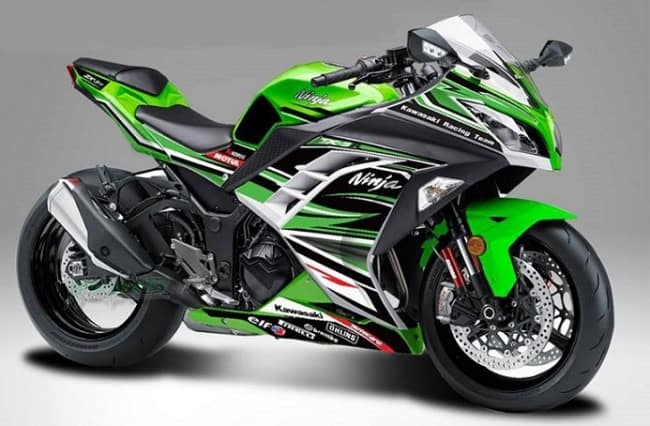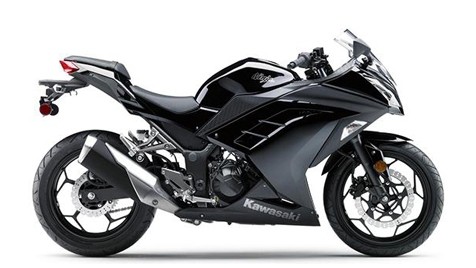The Kawasaki Ninja 300 is an impressive-looking motorcycle designed for sports riding. Ninja 300 Pros Cons: 300cc Kawasaki Ninja is an aggressively styled bike full of extra power than its predecessor 250R.
Some of the foremost remarkable features include its aerodynamic and aggressive styling, slipper clutch, powerful engine which are a number of the large reasons to shop for this bike.
The Ninja 300 is a bike that has style, technology, and performance to lead its class. Its competition-inspired clutch system and powerful 296cc fuel-injected engine make it often confused with larger displacement bikes.
Kawasaki Ninja 300: Main Features

Features of Kawasaki Ninja 300
 1. Comfortable Riding Posture
1. Comfortable Riding Posture
When it involves riding position and seating comfort, Ninja 300 is far almost like its younger sibling. The rear set foot-pegs give a sporty riding posture alongside the handlebar which allows elbows to possess an aerodynamic position.
Thus, the elbows and palms remain stress-free and have a firm grip on this bike. Moreover, the space on its fuel tank gives ample space to the knees to stay around it properly.
2. Slipper Clutch
The Kawasaki Ninja 300 comes with the choice of a slipper clutch. This slipper clutch comes into action when there’s a sudden downshift of the gears which frequently throws the wheel into a spin, catching the rider off-guard. The slipper clutch feature provides the rider with greater control and helps in changing the gears quickly.
3. Amazing Features
Ninja 300 has got attention-grabbing looks and features. To start with, the front fascia is boasted off by sharp twin headlights followed by an extended V-shaped pointed visor mounted with dark-hued back perspective mirrors which provides it a sporty and energetic look.
The back cowl includes a further LED taillight setup with side indicators fitted in its augmented back fender. Kawasaki Ninja 300 sportbike comes with dual lamp headlights with Daytime Running Lamps (DRL) and a multi-functional instrument console.
4. Engine Packed with Power
Kawasaki Ninja 300 has got a liquid-cooled, 4-stroke parallel twin 296cc, DOHC, 8 valves engine with a fuel-injection system. This powerful mill can churn out 38.5 Bhp of maximum power at 11.000 rpm against a maximum torque of 27 Nm at 10.000 RPM. This makes it more powerful than its predecessor.
5. Good Handling
Kawasaki Ninja 300 comes with an extended wheelbase and status clearance which provides better stability and turning abilities. It is a wheelbase of 1405 mm and therefore the suspension keeps it grounded during highway rides.
The ground clearance of 140 mm helps improve its aerodynamics during turns at slow speeds. You’d always feel confident while riding the bike both in city and highway conditions. Moreover, if you’re keen on highway rides, Ninja 300 will serve you well.
6. Dashboard
The dashboard is a modern and sporty design, reinforcing the sporty look of the Ninja 300. Several functions can be found on your LCD panels like the clock, speedometer, fuel level, and economical driving mode.
7. Aggressive and Sporty Style
It is the basic characteristic of Ninja, the aggressive and sporty style and with Ninja 300 it’s no different. Its design is minimalist but aggressive, striking, and quite sporty. Highlights are dual headlights and visors.
General Specification:
| Body Type: | Sports Bikes |
| ABS: | Single Channel |
| Starting: | Self-Start Only |
| Seat Type: | Split |
| Pass Switch: | Yes |
| Speedometer: | Digital |
| Tachometer: | Analogue |
| Trip Meter: | Digital |
| Low Fuel Warning Lamp: | Yes |
| Clock: | Digital |
| Passenger Footrest: | Yes |
| Cooling System: | Liquid Cooled |
| Low Battery Indicator: | Yes |
Kawasaki Ninja 300 Design
The Ninja 300 is based on the Ninja 250R, a lightweight and inexpensive sportbike in production for over three decades. Like the Ninja 250R, it has a full fairing, but a wider rear tire, 140/70, instead of the 130/70 on the 250R.
The Ninja 300 also has 5 spoke wheels, a neutral finder, and an optional antilock braking system (ABS).
By comparison with the 250R, the Ninja 300 also has a slightly smaller fuel tank, taller gearing, and a back-torque-limiting slipper clutch with an assist mechanism that decreases clutch lever effort.
Despite being a sportbike, it has comfortable ergonomics (such as a windscreen effectively protecting from windblast) which promotes commuting.
May You Like: Road race Motorcycles
Performance: The Kawasaki Ninja 300 has a 296 cc (18.1 cu in) straight-twin engine.
Dynamometer tests showed that the Ninja 300 produces more power with 39.95 hp (29.79 kW) compared with the 250s 25.48 hp (19.00 kW), and higher torque across the rev range at 18 to 13.57 lb-ft (24.40 to 18.40 N⋅m).
Its top speed has been recorded at 180 km/h (112 mph) and acceleration at 5.6 seconds from 0 to 97 km/h (0 to 60 mph), and around 14.5 seconds at 141.14 to 145.77 km/h (87.7 to 90.58 mph) in the quarter mile.
The stopping distance from 97 to 0 km/h (60 to 0 mph) of the ABS model was 38.0 to 41.1 m (124.6 to 135 ft). The Ninja 300’s fuel economy was measured at around 70 mpg‑US (3.4 L/100 km; 84 mpg‑imp), while other sources reported it at 54.1 mpg‑US (4.35 L/100 km; 65.0 mpg‑imp), though regardless of the methodology, the 300 showed improved gas mileage over the Ninja 250R.
Engine specification:
| Engine Type: | Parallel Twin, Liquid-cooled, 8-Valves, DOHC Engine |
| Engine Displacement: | 296 cc |
| Max Power: | 39 PS @ 11000 rpm |
| Emission Type: | bs6 |
| Max Torque: | 27 Nm @ 10000 rpm |
| Bore: | 62 mm |
| Stroke: | 49 mm |
| No Of Cylinders: | 2 |
| Drive Type: | Chain Drive |
| Valve Per Cylinder: | 4 |
| Fuel Type: | Petrol |
| Ignition: | Digital |
Transmission:
| Transmission Type: | Manual |
| No Of Gears: | 6 Speed |
Brakes:
| Brakes Front: | Disc |
| Brakes Rear: | Disc |
Chassis and Suspension:
| Suspension-Front: | 37 mm Telescopic Fork |
| Chassis: | Tube Diamond, Steel |
| Suspension-Rear: | Bottom-Link Uni-Trak with gas-charged shock and 5-way adjustable pre-load |
Tires and Wheels:
| Tire Size: | Front: -110/70-R17 Rear: -140/70-R17 |
| Wheel Size: | Front: -431.8 mm, Rear: -431.8 mm |
| Tire Type: | Tubeless |
| Radial Tire: | Yes |
| Wheels Type (Pressed Steel/ Alloy): | Alloy |
Electricals:
| LED taillights: | Yes |
| Turn Signal Lamp: | LED |
Dimensions:
| Length*Width*Height: | 2015*715*1110 mm^3 |
| Length: | 2015 mm |
| Wheelbase: | 1405 mm |
| Ground Clearance: | 135 mm |
| Height: | 1110 mm |
| Width: | 715 mm |
| Seat Height: | 785 mm |
| Fuel Capacity: | 17 Liters |
| Kerb Weight: | 179 Kg |
| Taillight: | LED |
| Front Brake Diameter: | 290 mm |
| Rear Brake Diameter: | 220 mm |
History:
| Manufacturer: | Kawasaki |
| Also called: | EX300 |
| Parent company: | Kawasaki Heavy Industries |
| Production: | 2012–Present |
| Predecessor: | Kawasaki Ninja 250R |
| Successor: | Kawasaki Ninja 400 |
| Class: | Sportbike |
About the author: Michael Parrotte was the Vice President of AGV Helmets America, and a consultant for KBC Helmets, Vemar Helmets, Suomy Helmets, Marushin Helmets, KYT Helmets, Sparx Helmets. In addition, he is the founder and owner of AGV Sports Group.




